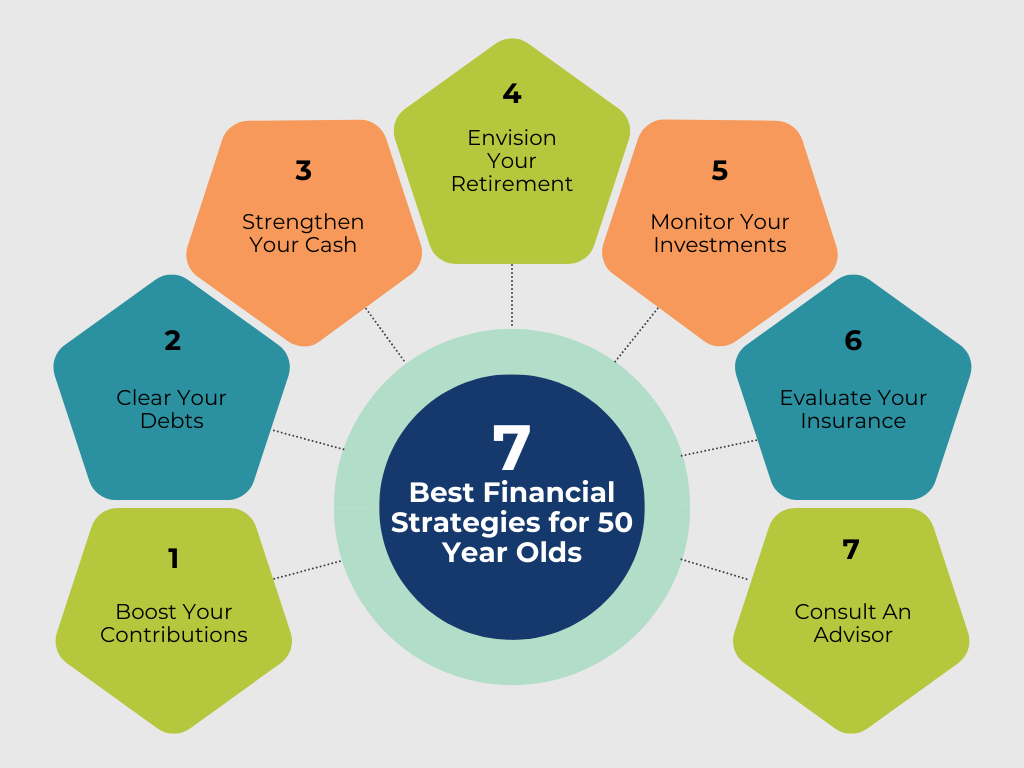Are you looking for the best financial strategies for 50 year olds?
Whether you are excited about retirement or you feel stress, wondering if you’ve put off financial planning a bit too long, this article will provide 7 great tips to put you on the right path!
Top 7 Tips: Financial Planning for 50 Year Olds
1. Boost Contributions to Your Retirement Plans
In your 50s, you can significantly increase your retirement contributions. At age 50, you become eligible for making catch-up contributions in your 401(k), 403(b), TSP, Roth IRAs and Traditional IRAs. This allows you to contribute more than the standard limit.
In 2025, you can contribute an extra:
- $7,500 to your 401(k) if you’re between age 50-59 or 64+
- $11,250 to your 401(k) if you are between age 60-63
- $1,000 to your Roth IRA or Traditional IRA if you are over age 50
Turning age 55 also allows you to make catch-up contributions to your HSA (Health Savings Account). In 2025, you are eligible to make a $1,000 additional catch-up contribution in your HSA. If you are married and you and your spouse have your own HSAs, you both can make a catch-up contribution of $1,000 at age 55+.
Catch-up contributions help you boost your retirement nest egg and have the potential to provide tax deductions in the year they are made.
2. Clear Any Remaining Debts
Entering retirement with the least amount of debt possible provides you with greater freedom.
While you are still employed, consider paying off your remaining debts in the following order of importance:
- Credit card debt
- Personal loans
- Car loans
- Student loans
- Mortgages
To pay off your debts quickly, consider using the “debt snowball” method or the “debt avalanche” method of debt elimination.
The “debt snowball” method suggests that you pay the minimum amount on all of your loans except your smallest loan balance. Pay as much extra as you can on this loan. Once it’s paid off, you would add everything you were paying to what you are paying on your next smallest loan.
The “debt avalanche” method of debt elimination works similarly. Instead of paying extra on your smallest loan balance, you would pay extra on your loan with the highest interest rate. The rest of the process is the same.
Eliminating these obligations will allow you to allocate more funds to your retirement savings and enjoy more of your income.
3. Strengthen Your Cash Savings
A solid emergency fund can protect your retirement savings from unexpected expenses. It can also provide you with peace of mind as you approach retirement.
How much cash you keep on hand is a personal preference. You might sleep well at night knowing that your emergency fund is robust enough to cover at least six months of your expenses. You might be comfortable with more or less.
Don’t forget to consider the amount of cash you have within your retirement accounts. Cash and conservative assets, such as bonds, can be used to generate income in periods where the stock market is down. The goal of using cash and bonds for income in down markets is to allow your aggressive holdings to recover without having to be sold at a loss.
4. Envision Your Ideal Retirement Lifestyle
Take some real time to visualize what you want your retirement lifestyle to look like. Here are some questions to ask yourself as you begin planning:
- Do you plan to travel or stay put?
- Do you want to start a new hobby or enjoy a current one more often?
- Will you spend more time with family?
- What will your life look like in practice if you get tired of golfing or travel?
- Who will you spend your time with on a regular basis?
- How will you maintain healthy relationships when you no longer see your colleagues each day?
- What activities will make you feel fulfilled when you no longer identify with your career as your identity?
Having a clear vision will help you set realistic expectations as well as determine how much you need to save. Clarity around these questions will guide your retirement planning and ensure your assets align with your goals.
5. Monitor and Adjust Your Investment Portfolio
As retirement approaches, it’s important to reassess the risk and income potential of your investment portfolio. Your asset allocation (mix of investments) should include:
- Growth Assets – to build your savings throughout retirement and keep up with inflation
- Conservative Assets – to reduce market volatility and protect you in down markets
The asset allocation of your retirement plan should be able to produce your desired income while not exceeding your comfort with risk. Keep in mind that you may have to withhold taxes from your investment distributions. Consult with a professional to figure out a sustainable withdrawal and tax withholding strategy for your situation.
6. Evaluate Your Insurance Needs and Risks
It’s easy to ignore the risk of your retirement goals being negatively affected by health or life events. Consider reviewing your insurance policies to ensure you have adequate coverage to protect yourself and your loved ones.
Life Insurance
Life insurance provides your beneficiaries a tax-free sum of money in the event of your death. It can be especially important if you are married and your combined income is needed to cover your current expenses.
Reviewing your life insurance needs can also help you eliminate insurances that don’t fit your current situation.
Example: Finding out that you are paying monthly for a whole life insurance policy that would only cover burial expenses. Instead you might really need multiples of your income in coverage to protect your spouse.
Disability Insurance
Disability insurance can be powerful by replacing a portion of your income if you are disabled prior to retiring or age 65. You may be able to purchase this through your employer’s group benefits or it may be provided to you at no cost. You will likely not carry this type of insurance into retirement.
Long-Term Care Insurance
Long-term care insurance is also worth exploring. The costs of extended chronic care can quickly deplete your retirement assets.
If you are single in retirement or have a family history of Alzheimers or dementia, you might have a higher risk of needing to pay for some type of chronic care in retirement.
Long-term care insurance is usually expensive and not the only way to pay for care so be sure to speak to a professional about your situation.
Estate Planning
In addition to reviewing your insurance, your 50s are an ideal time to consult with an estate planning attorney. Consider making sure that your estate plan will properly pass your assets to your loved ones when you are no longer here.
7. Consult with a Financial Advisor
Consider consulting with a financial advisor who specializes in financial planning and retirement planning. When building your financial plan, your advisor may offer advice on the following topics:
- Achieving your retirement goals
- Maximizing your retirement contributions and investment strategies
- Planning your Social Security retirement benefits and pensions
- Reviewing your estate plan and insurances
- And more
You may be worried about creating a secure income in retirement or planning for medicare. You might also want to keep as much of your retirement income as possible by lowering your tax liabilities.
A financial advisor who specializes in retirement planning can provide you with peace of mind and confidence.
How Is Financial Planning Different in Your 50s?
Financial planning in your 50s is distinct from earlier decades because you’re closer to retirement and your financial priorities have likely shifted. At this STAGE of life, you’re preparing to transition from earning a paycheck to relying on your savings and investments.
There’s less time to recover from financial missteps, making it important to be more strategic and focused in your retirement planning.
Schedule a Free Consultation to Make the Most of Your 50s and Beyond
At Stage Ready Financial Planning, we specialize in fee-only financial planning for individuals and couples over age 50 in Dayton & Southwest, Ohio.
We help you create a clear and easy to understand plan so that you can retire with confidence and live your ideal lifestyle. Schedule your intro call today!
FAQs
How much money should a 50-year-old have saved?
The amount of retirement savings you need will depend on when you plan to retire and how much retirement income you want. Here’s a comparison chart that illustrates how much a 50-year-old should have saved to retire at various ages, based on different withdrawal needs.
Assumptions:
- Annual Investment Withdrawal Needs: The table assumes gross investment withdrawal needs of $50,000, $75,000, $100,000, and $125,000 per year.
- Growth Rate: An annual growth rate of 5% on investments is assumed before and during retirement.
- Withdrawal Rate: The chart assumes an example withdrawal rate of 4% at retirement.
- Contributions: The chart assumes $8,000 per year in contributions that stop at retirement.
- Length of Retirement: 30 years approximately
How can I build wealth in my 50s?
Some great ways to build wealth in your 50s include taking advantage of catch-up retirement contributions and being focused on debt reduction. If you have a financial plan, it can be exciting to see the difference in your retirement projections by paying down your debt in a systematic way and increasing your retirement accounts quickly by taking advantage of higher contribution limits.
Is it too late to start a 401(k) at 50?
It’s never too late to start saving for retirement. Setting up a 401(k) at 50 allows you to take advantage of catch-up contributions. You can contribute more than you would have been able to in your 30s and 40s, allowing you to boost your retirement savings quickly and grow your retirement nest egg.


